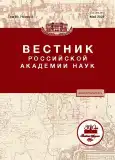Searching for a social optimum: Chasing a ghost?
- Autores: Nekipelov A.D.1
-
Afiliações:
- Moscow School of Economics, Moscow State University
- Edição: Volume 93, Nº 5 (2023)
- Páginas: 415-427
- Seção: НАУКА И ОБЩЕСТВО
- URL: https://journals.rcsi.science/0869-5873/article/view/140546
- DOI: https://doi.org/10.31857/S0869587323050080
- EDN: https://elibrary.ru/VWVSWU
- ID: 140546
Citar
Texto integral
Resumo
A new methodological approach to identify the nature of the group optimum is employed. Its constituent elements are the rejection of a unified perception of the problem in relation to all types of groups, as well as its separate consideration in conditions of certainty and uncertainty. The social optimum is considered as a state of coherence of the interests of members of society, and its nature is identified within the framework of the analysis of a “simple integral group” under conditions of certainty. The necessity of an “institutional lining”—an agreed principle of social choice—between individual preferences and the social optimum is substantiated. The limited possibilities for obtaining and processing information, which is characteristic of conditions of uncertainty, give rise to the need for the formation of a mechanism of social choice, designed to provide the possibility of maximum approximation to the social optimum constructed in this way. It is shown that the most important consequence of the existence of systemic costs associated with the operation of any such mechanism is the emergence of small groups and the transformation of a simple integral group into a complex one. The characteristic features of the three most important types of small groups are determined: the governing bodies of a “large group,” enterprises (firms), and households, which play the most important role in the functioning of the economic system. The absence of an unambiguous definition of the point of the social optimum and the ideal mechanisms for achieving it are opposed by the awareness by members of society of the undoubted benefits from cooperation with each other. As a result, social structures are relatively stable. At the same time, in comparison with natural objects, they have obvious characteristic features, which inevitably affects the nature of the social sciences.
Sobre autores
A. Nekipelov
Moscow School of Economics, Moscow State University
Autor responsável pela correspondência
Email: vestnik.ran@yandex.ru
Moscow, Russia
Bibliografia
- Arrow K. Social Choice and Individual Values. N.Y.; L.: John Wiley & Sons, Inc., Chapman & Hall, 1951.
- Arrow K. Social Choice and Justice. Cambridge, Massachusetts: The Belknap Press of Harvard University Press, 1983.
- Pareto V. Manuel d’économie politique, deuxième edition. Paris: M. Giard, 1927.
- Рубинштейн А. Структура и эволюция социального интереса. Препринт. М.: ИСЭ Пресс, 2003.
- Grinberg R., Rubinstein A. Economic Sociodynamics. Springer, 2005.
- Buchanan J. Public Finance in Democratic Process. Fiscal Institutions and Individual Choice. Chapel Hill: The University of North California Press, 1967.
- Bergson A. A Reformulation of Certain Aspects of Welfare Economics // Quarterly Journal of Economics. 1938. V. 52. P. 310–334.
- Сен А. Возможность общественного выбора. Нобелевская лекция. 8 декабря 1998 г. / Политикам об экономике. Лекции нобелевских лауреатов по экономике. М.: Современная экономика и право, 2005.
- Kaneko M., Nakamura K. The Nash Social Welfare Functions // Econometrica. 1979. № 47. P. 423–436.
- Nash J. The Bargaining Problem // Econometrica. 1950. № 18 (2). P. 155–162.
- Некипелов А. Становление и функционирование экономических институтов. От “робинзонады” до рыночной экономики, основанной на индивидуальном производстве. М.: Экономистъ, 2006.
- Хайек Ф. Дорога к рабству. М.: Новое издательство, 2005.
- Silberberg E. The Structure of Economics. A Mathematical Analysis. Second Edition. McGraw-Hill Publishing Company, 1990.
- Вагнер Р. Фискальная социология и теория государственных финансов. Исследовательское эссе // Экономическая социология. 2016. Т. 17. № 2. Март. С. 88–110.
- Hindriks J., Myles G. Intermediate Public Economics. 2nd ed. Cambridge, MA: MIT Press, 2013.
- Маркс К. Критика Готской программы / Маркс К., Энгельс Ф. Соч. Изд. 2-е. М.: Госполитиздат, 1961. Т. 19. С. 9–32.
- Ведута Н.И. Социально эффективная экономика / Под общей ред. д-ра экон. наук Е.Н. Ведуты. М.: Изд-во РЭА, 1999.
- Coase R. The Nature of the Firm // Economica. 1937. № 4 (16). P. 386–405.
- Некипелов А.Д. Кризис в экономической науке – природа и пути преодоления // Вестник Российской академии наук. 2019. № 1. С. 24–37.
- Полтерович В.М. Становление общего социального анализа // Общественные науки и современность. 2011. № 2. С. 101–111.










